Gear Reviews
Review – 3 Leaf Audio Octabvre, Wonderlove and Doom Pedals
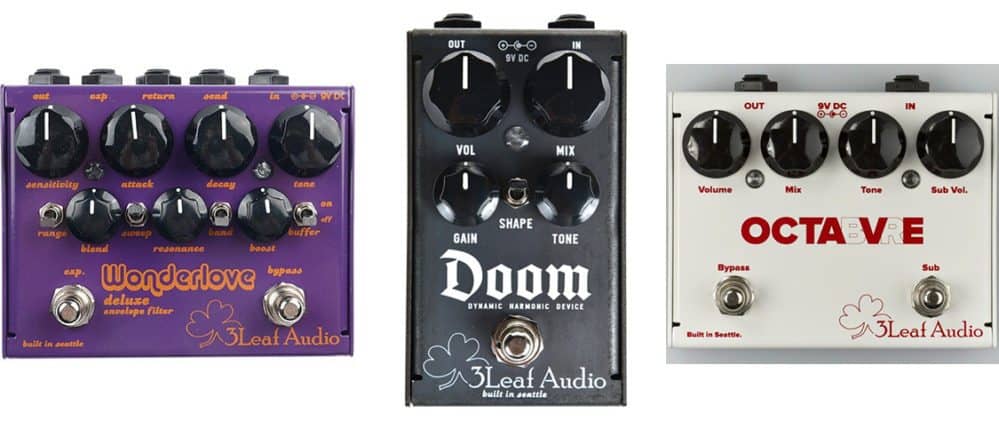

3 Leaf Audio Octabvre, Wonderlove and Doom Pedal Reviews
Back in the late 70’s and 80’s, synth/keyboard bass was in its heyday, appearing on all kinds of records, supplanting the organic electric bass tone we fell in love with in the 60’s and 70’s. While synth bass’s day in the sun didn’t last for too long, there has been an undeniable resurgence of electric bass players trying to cop the synth tones that bubbled up during that era. Nowadays, if you want your electric bass to sound like a synthesizer, you have a couple of options: You can go with a “one stop shop” multi-effect or synth pedal, (for example, the popular Boss Bass Synth, MarkBass Super synth, or the coveted Akai Deep Impact) which contain all of the sonic components that comprise synth bass tone, namely: octave, envelope filter and distortion. Alternatively, you can get those tones from individual pedals in a certain order. In the last few years, I’ve been dialing in my synth bass sound with the latter method, handpicking different effects geared toward my ideal synth tone. I much prefer the ‘modular’ approach, as it lets me tweak the individual sonic puzzle pieces, AND also lets me use any of those pieces by itself, which I end up doing a lot more than using the full blown synth sounds.
In my quest to find the ultimate octave and envelope effects, I inevitably became hip to 3 Leaf Audio, makers of exquisitely designed and built effect pedals. First thing first: the build quality and componentry is superb. The enclosures are heavy duty and solid feeling, switches and knobs all feel smooth and sturdy, and even the paint jobs and graphics show a keen eye for detail and design. Spencer Doren opened 3 Leaf Audio in 2008, borne of a lack of satisfaction with offerings at the time. It started with mods and tweaks of existing pedals and soon he started designing and producing his own pedals. He currently offers a range of pedals that, when used in combination, provide lusciously deep and syrupy synth tone. Let’s go through the pedals one by one.
First up is the 3 Leaf Audio Octbavre MKII Octave pedal.

The Octabvre is based on the tonal blueprint of older Boss OC-2 octave pedals, which are widely regarded as the high water mark for processed sub-octave synth bass goodness for electric bass. Not the fastest or most transparent unit out there, users usually agree that there’s some weird magic in those pedals that just sounds great, and transforms your bass into a straight up booty machine. If you’re wondering about the name, the pedal gets its name from bassist extraordinaire Tim Lefebvre (David Bowie, Krantz Carlock, Lefebvre, Tedeschi Trucks Band); one of the true pioneers in the modern movement of electric bass players seeking righteously synthy bass tones. One thing that sets the Octabvre apart from other octavers is that it features 2 different settings that are switchable via footswitches. On the left side you have a super-fast tracking, warm sub octave that allows you to tailor both the mix level of dry/wet as well as control the overall output level. Kick in the right side, and you get vintage ‘sub-octave only’ OC-2 heaven: big, dirty, synthy grit with loads of bottom and a tone knob that allows for some adjustment of high and mid frequency presence. With the tone set at its lower range, it is very reminiscent of my MIJ Boss OC2, and just the way I like it! Sidebar: I always had a love/hate relationship with my vintage OC2. I loved its tone when engaged, but It didn’t track as fast as I wanted it to, it was pretty finicky about input levels, and despite having a great sub-octave tone, in bypass mode I found it to be a real tone sucker. I found I had to keep the OC2 on a true bypass loop in order to not deal with subpar tone when the unit was bypassed. The Octabvre Mk II also features the “Tim Tuning” switch, which, according to Spencer is more true to the OC2 tone. I found the Tim Tuning to be a little deeper and purer sounding, and have less gritty mids than the switches other position. I ended up using Octabvre in “Tim mode” all the time. Spencer also notes that the new Octabvre Mini (a more affordable version with less features) offers only one voicing, and it’s a modified version of the Tim Tuning setting. When I asked Spencer about the ideas behind this pedal, he told me that he used to go see Lefebvre when he played in NYC at the 55 bar with Wayne Krantz (lucky dog!). Spencer says: “I’ve been a fan of Tim’s playing for years. I used to see him play at the 55 Bar in New York back when I lived there. My playing style is somewhat similar to his and I figured he would dig my creations, so I got in touch with him and sent him a few stomp boxes. We got along immediately and a few months later I started working on the design for the Octabvre. The idea for that pedal came about because I would always see Tim bend down in the middle of a song to turn off the dry knob on his OC-2, and I figured a 2nd footswitch that cut the dry signal would let him use the octaver effect more effectively.” Thus the Octabvre was born!
Next up is the 3 Leaf Audio Wonderlove Envelope Filter.
 It’s pretty hard to imagine that so much control and versatility can be housed in a stomp box sized enclosure, but the Wonderlove manages to offer a level of control over its effect that is pretty much unparalleled in the current market. Back in the day, there was the coveted Lovetone Meatball, which offered a similar amount of control over parameters, but is was big and clunky, and these days, fetches astronomical prices on the used market. The Wonderlove does everything a good envelope filter should do, and a few other cool things. It allows you to control the input sensitivity, the attack and release speed, and the resonance level, and it offers things like: a dry/wet blend knob, a footswitchable expression pedal (to mimic a manual wah-wah pedal), a global tone knob for sonic seasoning to taste, and (most ‘hip-ly’), a selectable buffer circuit with an fx loop. Why is this hip? Well, say you want to run an octave and fuzz before your envelope, because that’s the tone you like, BUT… doing that causes all kinds of weirdness for how the envelope filter “sees” the input (they tend to like clean consistent signals to work properly), this loop allows you to run your effects in this hypothetically preferred method, while hitting the envelope filter with your clean signal, so the envelope functions consistently and smoothly, no matter if the octave or fuzz are engaged. Overall, I was super impressed with the Wonderlove, mainly because it allowed me to tailor EXACTLY the kind of filter effect I was going for. Most filter pedals opt for simplicity, whereas the Wonderlove goes for maximum tweakability. While this may be off-putting for some, for those willing to put the work in, they are rewarded with a very finely tuned envelope filter sound that has exceptional tone and responsiveness and can be adjusted towards a number of tonal options. After a little learning curve, I was able to dial in bootsy funk, lyrical vowel-like soloing tones, and all kinds of bubbly weirdness. I seriously can’t imagine wanting for another filter pedal after being spoiled by the Wonderlove!
It’s pretty hard to imagine that so much control and versatility can be housed in a stomp box sized enclosure, but the Wonderlove manages to offer a level of control over its effect that is pretty much unparalleled in the current market. Back in the day, there was the coveted Lovetone Meatball, which offered a similar amount of control over parameters, but is was big and clunky, and these days, fetches astronomical prices on the used market. The Wonderlove does everything a good envelope filter should do, and a few other cool things. It allows you to control the input sensitivity, the attack and release speed, and the resonance level, and it offers things like: a dry/wet blend knob, a footswitchable expression pedal (to mimic a manual wah-wah pedal), a global tone knob for sonic seasoning to taste, and (most ‘hip-ly’), a selectable buffer circuit with an fx loop. Why is this hip? Well, say you want to run an octave and fuzz before your envelope, because that’s the tone you like, BUT… doing that causes all kinds of weirdness for how the envelope filter “sees” the input (they tend to like clean consistent signals to work properly), this loop allows you to run your effects in this hypothetically preferred method, while hitting the envelope filter with your clean signal, so the envelope functions consistently and smoothly, no matter if the octave or fuzz are engaged. Overall, I was super impressed with the Wonderlove, mainly because it allowed me to tailor EXACTLY the kind of filter effect I was going for. Most filter pedals opt for simplicity, whereas the Wonderlove goes for maximum tweakability. While this may be off-putting for some, for those willing to put the work in, they are rewarded with a very finely tuned envelope filter sound that has exceptional tone and responsiveness and can be adjusted towards a number of tonal options. After a little learning curve, I was able to dial in bootsy funk, lyrical vowel-like soloing tones, and all kinds of bubbly weirdness. I seriously can’t imagine wanting for another filter pedal after being spoiled by the Wonderlove!
And finally, the 3 Leaf Audio DOOM Fuzz.
 I’m gonna be the first to admit that I’m not a huge fuzz aficionado. I like a nice dirty fuzz tone, but typically opt for cleaner tones, generally speaking. Whether that makes me a particularly bad or good person to review a fuzz pedal will have to be up to you. Let me make a case for the latter. I don’t like a lot of fuzz pedals, as they can kill dynamics and low end punch, sound un-natural and have too much of a baked in distortion level. The Doom Pedal really surprised me with its uniqueness and dynamic range. At its lower settings, it has a very reactive dynamic presence, which I like. I was able to “play the effect” by varying how much I dug in with my right hand, and it offered a very responsive experience, which appealed to me immediately. As you crank up the gain levels and open up the tone, the DOOM served up everything from creamy, to snarly to downright synthy glitch. At certain settings it sounds brassy and processed in a very synth friendly manner. The DOOM really excels in combination with the Wonderlove and the Octabvre. Using the three in conjunction with each other was straight up addictive, and dished out Moog-worthy synth tones, that would make any keyboard bass fan smile. The grittiness of the DOOM really brings out the tone of the other pedals, and I found myself wanting to play Boogie On Reggae Woman over, and over and over. It’s just a flat out enjoyable pedal combo, which makes perfect sense, given the family tree.
I’m gonna be the first to admit that I’m not a huge fuzz aficionado. I like a nice dirty fuzz tone, but typically opt for cleaner tones, generally speaking. Whether that makes me a particularly bad or good person to review a fuzz pedal will have to be up to you. Let me make a case for the latter. I don’t like a lot of fuzz pedals, as they can kill dynamics and low end punch, sound un-natural and have too much of a baked in distortion level. The Doom Pedal really surprised me with its uniqueness and dynamic range. At its lower settings, it has a very reactive dynamic presence, which I like. I was able to “play the effect” by varying how much I dug in with my right hand, and it offered a very responsive experience, which appealed to me immediately. As you crank up the gain levels and open up the tone, the DOOM served up everything from creamy, to snarly to downright synthy glitch. At certain settings it sounds brassy and processed in a very synth friendly manner. The DOOM really excels in combination with the Wonderlove and the Octabvre. Using the three in conjunction with each other was straight up addictive, and dished out Moog-worthy synth tones, that would make any keyboard bass fan smile. The grittiness of the DOOM really brings out the tone of the other pedals, and I found myself wanting to play Boogie On Reggae Woman over, and over and over. It’s just a flat out enjoyable pedal combo, which makes perfect sense, given the family tree.
As mentioned above, all three of the 3 Leaf pedals have exceptionally high quality feeling build quality, are housed in heavy duty enclosures with great paint and graphics, and clearly employ top shelf jacks and switches. There isn’t anything to nitpick about with any of these pedals, that wouldn’t be filed under “subjective”, and I can say with confidence that Spencer knocked these 3 pedals out of the park. Whether you’re looking for just the right octave pedal, envelope filter, or dynamic fuzz effect, or a full blown bass synth channel, you seriously owe it to yourself to check out the 3 Leaf product line. The Octabvre MkII sells direct for $259, The Wonderlove for $299, and the DOOM for $219. For more information, visit 3 Leaf on the web at www.3leafaudio.com
Video links:
- Victor Wooten plays the DOOM
- Victor Wooten plays the Wonderlove
- Ryan Stasik of Umphree’s McGee on the DOOM and Wonderlove
- Paul Turner of Jamiroquai checks out the DOOM and Wonderlove
Bass Videos
Review: CrystalBright Rombo Picks
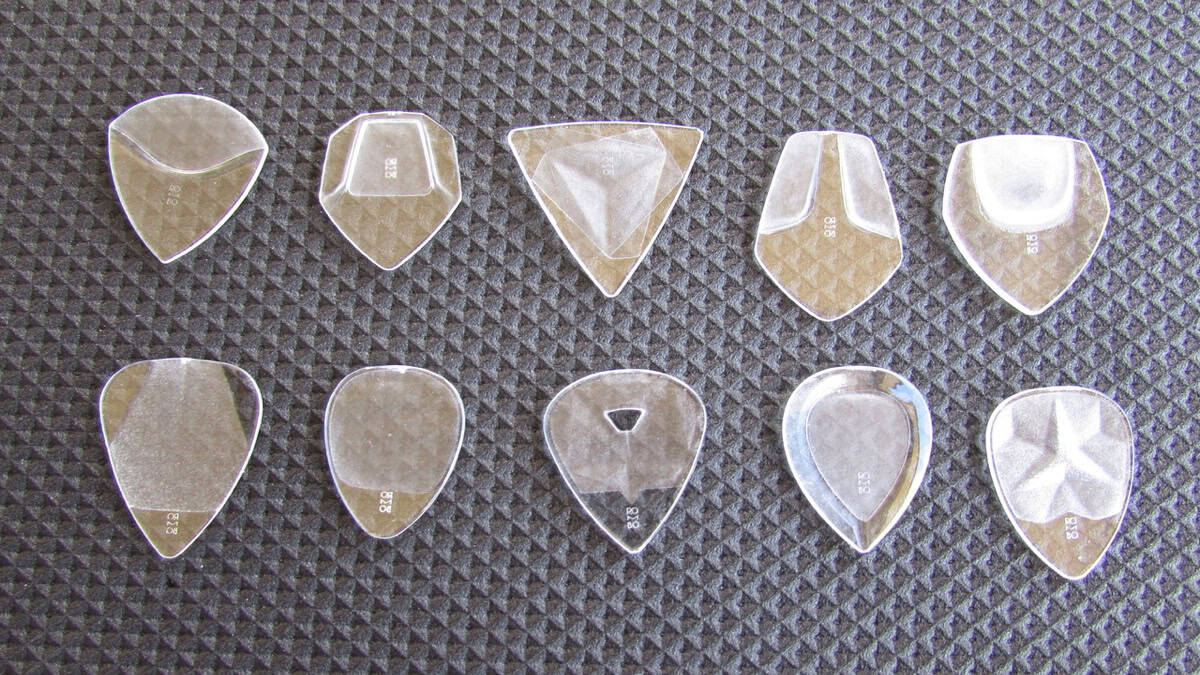
CrystalBright Rombo Picks
PR SamplePlaying bass with a pick is still a touchy subject in our community. I believe you should be able to use whatever you need to get your sound. Even though I mostly play with my fingers, I like to check out innovative new picks that might have something new to offer, sonically speaking.
Judith and Carlos from Rombo recently contacted me about a new material called CrystalBright that they have been researching for the last 12 months and offered to send some prototype picks. After trying them out, I put together this video with my findings.
For more info check out @rombopicks
Gear
New Joe Dart Bass From Sterling By Music Man

Sterling by Music Man introduces the Joe Dart Artist Series Bass (“Joe Dart”), named after and designed in collaboration with the celebrated Vulfpeck bassist.
Above photo credit: JORDAN THIBEAUX
This highly-anticipated model marks the debut of the Dart bass in the Sterling by Music Man lineup, paying homage to the Ernie Ball Music Man original that all funk players know and love. The bass embodies many of the original model’s distinctive features, from its iconic minimalist design to the passive electronics.

The design process prioritized reliability, playability, and accessibility at the forefront. Constructed from the timeless Sterling body, the Dart features a slightly smaller neck profile, offering a clean tone within a comfortable package. The body is crafted from soft maple wood for clarity and warmth while the natural finish emphasizes the simple yet unique look.
Engineered for straightforward performance, this passive bass features a ceramic humbucking bridge pickup and a single ‘toaster’ knob for volume control. Reliable with a classic tone, it’s perfect for playing in the pocket. The Dart is strung with the all-new Ernie Ball Stainless Steel Flatwound Electric Bass Strings for the smoothest feel and a mellow sound.

The Sterling by Music Man Joe Dart Bass is a special “Timed Edition” release, exclusively available for order on the Sterling by Music Man website for just one month. Each bass is made to order, with the window closing on May 31st and shipping starting in November. A dedicated countdown timer will indicate the remaining time for purchase on the product page. Additionally, the back of the headstock will be marked with a “2024 Crop” stamp to commemorate the harvest year for this special, one-of-a-kind release.
The Joe Dart Bass is priced at $399.99 (MAP) and can be ordered globally at https://sterlingbymusicman.com/products/joe-dart.
To learn more about Joe Dart, visit the official Vulfpeck artist site here https://www.vulfpeck.com/.
Gear Reviews
The Frank Brocklehurst 6-String Fretless Bass Build
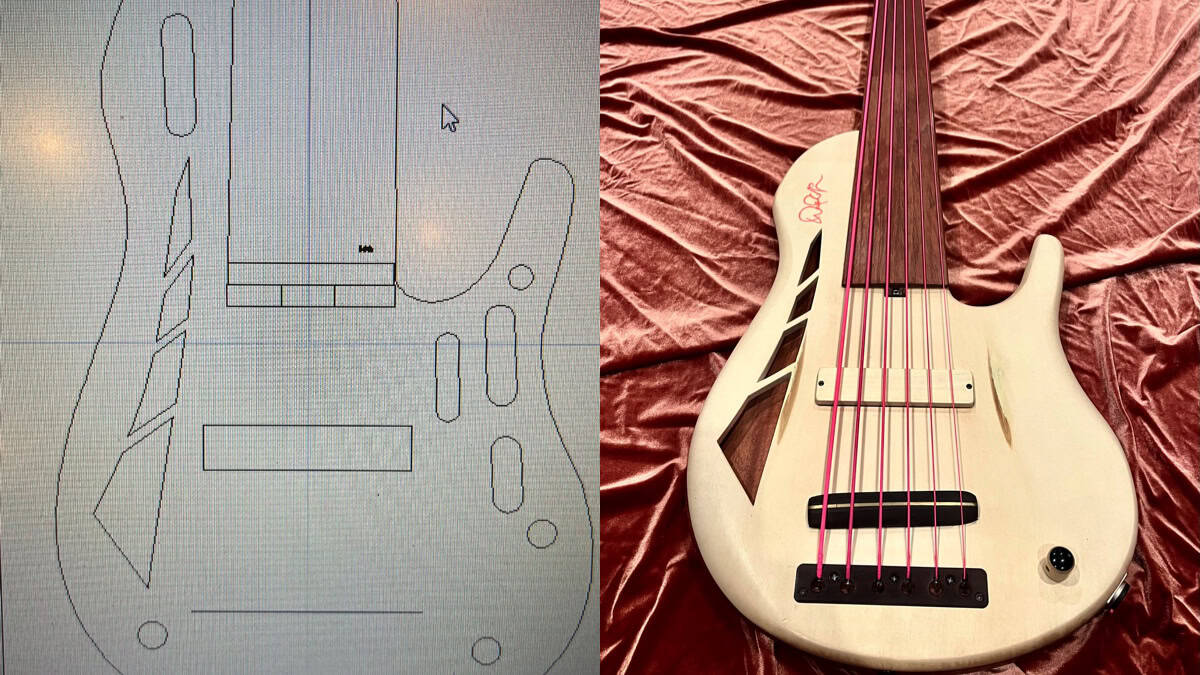
A few months ago, my Ken Bebensee 6-string fretted bass needed some TLC. You know, the one rocking those Pink Neon strings! I scoured my Connecticut neighborhood for a top-notch luthier and got pointed to Frank Brocklehurst, F Brock Music. He swung by my place, scooped up the bass, and boom, returned it the next day, good as new. Not only that, he showed up with a custom 5-string fretted bass that blew me away. I couldn’t resist asking if he could whip up a 6-string fretless for me.
Alright, let’s break down the process here. We’ve got our raw materials: Mahogany, Maple, and Holly. Fun fact – the Mahogany and Maple have been chilling in the wood vault for a solid 13 years. Frank is serious about his wood; they buy it, stash it away, and keep an eye on it to make sure it’s stable.

First up, they’re tackling the Mahogany. Frank glues it together, then lets it sit for a few days to let everything settle and the glue to fully dry. After that, it’s onto the thickness planer and sander to get it nice and flat for the CNC machine. The CNC machine’s the real star here – it’s gonna carve out the body chambers and volume control cavity like a pro.

While the Mahogany’s doing its thing, Frank goes onto the neck core. Three pieces of quartersawn maple are coming together for this bad boy. Quartersawn means the grain’s going vertical. He is also sneaking in some graphite rods under the fingerboard for stability and to avoid any dead spots. The truss rod is going to be two-way adjustable, and the CNC machine’s doing its magic to make sure everything’s just right.

Now, onto the design phase. Frank uses CAD software to plan out the body shape, neck pocket, chambering, and those cool f-holes. I had this idea for trapezoid F-holes, just to do something different. The CAD software also helps us map out the neck shape, graphite channels, and truss-rod channel with pinpoint accuracy.

Once everything’s planned out, it’s CNC time again. Frank cuts out the body outline, neck pocket, and the trapezoid F-holes. Then it’s a mix of hand sanding and power tools to get that neck just how we like it. Oh, and those f holes? We’re going for trapezoids of different sizes – gotta keep things interesting.

Next step: gluing that neck into the pocket with some old-school hide glue. It’s got great tonal transfer and can be taken apart later if needed. Then it’s onto hand-carving that neck-body transition.

For the custom-made bridge, Frank uses brass for definition and Ebony for tonal transfer and that warm, woody sound.

BTW, for tunes, Frank went with Hipshot Ultralights with a D Tuner on the low B. This way I can drop to a low A which is a wonderful tone particularly if you are doing any demolition around your house!
Now it’s time for the side dots. Typically, on most basses, these dots sit right in the middle of the frets. But with this bass, they’re placed around the 1st, 3rd, 5th, 7th, 9th, and 12th frets.

Frank’s got his pickup hookup. Since the pickup he was building wasn’t ready, he popped in a Nordstrand blade to give it a whirl.

It sounded good, but I was itching for that single-coil vibe! And speaking of pickups, Frank showed me the Holly cover he was cutting to match, along with all the pink wire – talk about attention to detail!

A couple of things, while it is important for me to go passive, it is equally important for me to just go with a volume knob. Tone knobs are really just low-pass filters and the less in the way of a pure sound for me, the better.
Finally, it’s string time! As usual, I went for the DR Pink Neon strings. Hey, I even have matching pink Cons…Both low tops and high!

Once we’ve got everything tuned up and settled, we’ll give it a day or two and then tweak that truss rod as needed. And voila, we’ve got ourselves a custom-made bass ready to rock and roll.

I want to thank Frank Brocklehurst for creating this 6 string beast for me.
Gear Reviews
Review Transcript: BITE Custom Bass – The Black Knight PP Bass
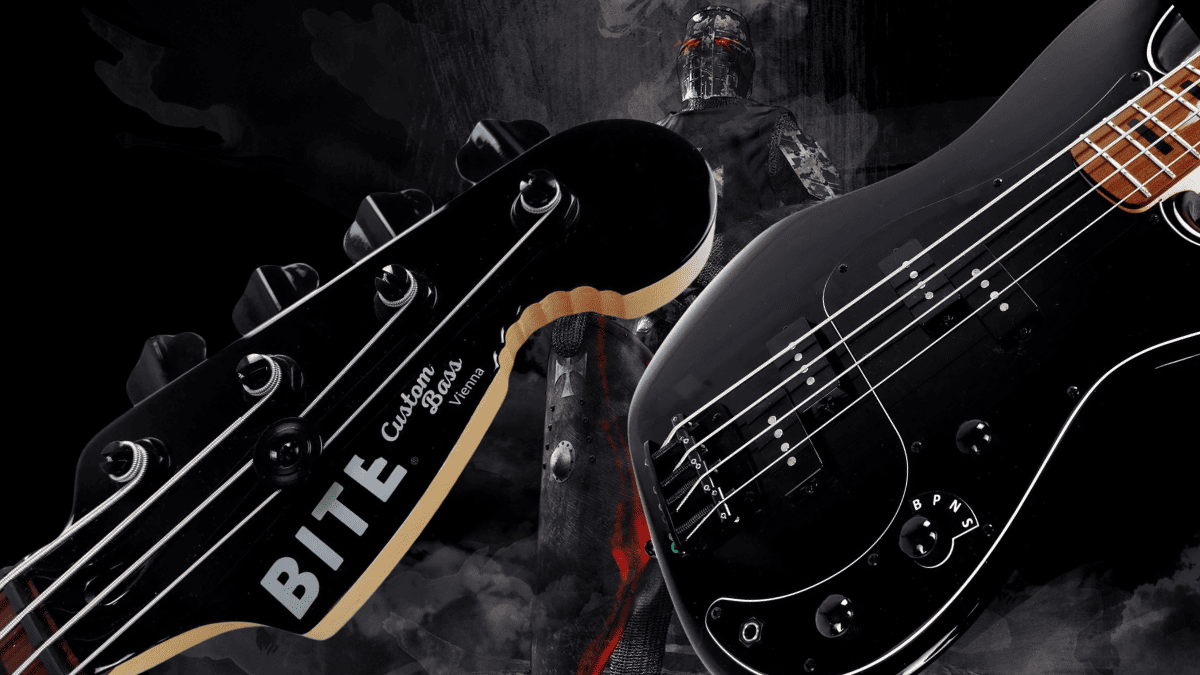
This is a written transcript of our video review of the BITE Custom Bass Black Knight PP Bass originally published on March 4, 2024
BITE Custom Bass – The Black Knight PP Bass Review…
Bass Musician Magazine did a review on a Steampunk bass from BITE Guitars about three years ago, it was an amazing instrument, and we were very impressed. Now we’re happy to bring you another BITE bass, the Black Knight PP.

Everybody needs a P-type bass, it’s the standard of bass. If you’re recording, they want you to have a P bass. So why not have something that gives you a little more by having two instead of one P pickup. That’s the idea of this bass, it’s the first thing that leaps out: the double P pickup configuration.

Installing two of their 1000 millivolt split-coil pickups, BITE then went one step further and wired them up in a 4-way parallel/series circuit, a look at the controls reveal a 4-way rotary selector:
The first position, marked “B”, gives you the bridge pickup by itself.
The second position, marked “P”, gives you the bridge and neck pickups in parallel mode, that’s the traditional J-type circuit, it reduces output due to the physical law of parallel circuits.
Position number 3 is marked “N”, it gives you the neck pickup by itself.
And finally, number 4, marked “S”, gives your bridge and neck in a series (humbucking) mode which adds up resistances and thus boosts output. The other two controls are master volume and master tone.

What’s more, like every BITE bass, this one also has a reinforced headstock heel designed to give it extra output and sustain. The BITE website features a graph and explanation of what they have done to the heel, as compared to traditional headstocks.

A look at the body reveals a beautiful Black Blast body finish and underneath that we have alder wood. The bass has a matching headstock with a 4-in-line tuner setup and the traditional bite out of it, so everybody will know what kind of bass you’re playing. The pickguard is 3-ply black, the neck is vintage tinted hard maple and it has a satin speed finish at the back which keeps your thumb from sticking.
On top of that, there’s a clear-coated roasted black locust fretboard with black blocks marking the frets. The nut is a black Graph Tec nut, we’ve got diamond dome control knobs, and the tuners are lightweight compacts with cloverleaf buttons and a 1:17 ratio precision gear. The bridge is a Gotoh brass bridge with 19-millimeter string spacing.
Overall measurements: we’ve got a standard 34″ scale, a 1.65″ width nut and a C neck profile. This bass weighs 8.2 pounds, or 3,7 kilograms for our metric friends, and it uses standard 18% nickel silver frets.
Taking a closer look at the sound, this bass is a joy to play. The BITE proprietary 1000 millivolt pickups deliver an extraordinary amount of output which is surprising considering this is a passive instrument. You may even want to set your amp to active mode because of all of the juice you’re getting out of this guy.
The tonal possibilities are very versatile, it’s a straight P if you want but also much more with those different arrangements of the circuitry. So why have multiple basses when you’ve got one that can give you your basic P plus a lot more?
To sum it up, the Black Knight PP is an amazing instrument. The attention to detail that BITE puts into their basses is second to none. This bass is also amazingly balanced and gorgeous to hold and feel with the satin neck finish.
For more information, visit online at bite.guitars/product/black-knight-pp
Bass Videos
Reviews: Phil Jones Bass Compact Plus 450 and Bass Engine 17
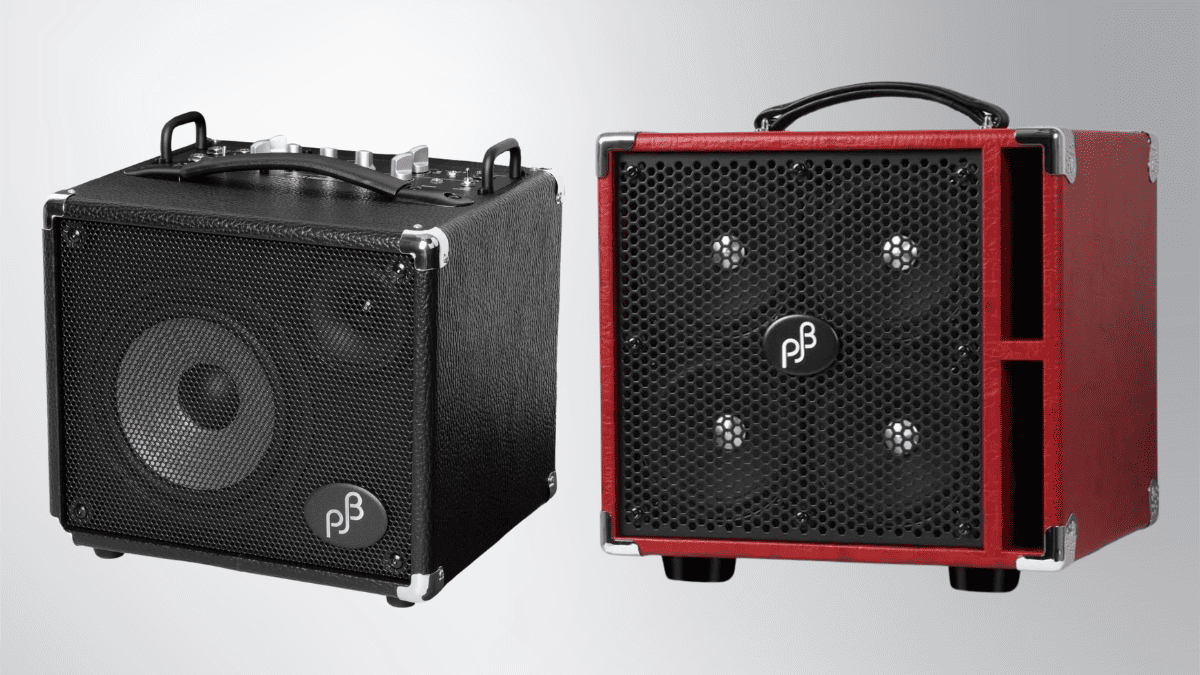
Phil Jones Bass Compact Plus 450 and Bass Engine 17 Reviews…
In this issue, we take an in-depth look at two new amps from Phil Jones Bass, the Compact Plus 450 and Bass Engine 17.
For more information, visit online at pjbworld.com












